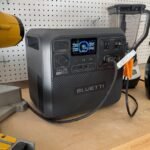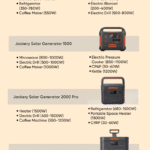Disclosure: This post contains affiliate links and I will be compensated if you make a purchase after clicking through my links. Learn More
To charge a Westinghouse generator battery, connect it to a compatible charger and plug it into a power source. Ensure the generator is off during charging.
Westinghouse generators are known for their reliability and efficiency. Proper battery maintenance ensures your generator is always ready when needed. Charging the battery correctly is crucial to avoid damage and prolong its life. Always use a charger recommended by the manufacturer to prevent any compatibility issues.
Regular charging keeps the battery in optimal condition, ensuring your generator starts without issues during power outages. Understanding the charging process helps maintain the generator’s performance and reliability. This guide will provide you with clear steps for effective battery charging, ensuring your Westinghouse generator remains dependable.
Safety Precautions
Charging your Westinghouse generator battery requires careful attention to safety. Follow these precautions to avoid accidents and ensure a smooth process.
Wear Protective Gear
Always wear protective gear when charging the battery. This includes safety glasses and gloves. Safety glasses protect your eyes from any sparks. Gloves keep your hands safe from harmful chemicals.
Ensure your clothing is not loose. Loose clothes can get caught in moving parts. Wear closed-toe shoes to protect your feet.
Avoid Open Flames
Keep the charging area free of open flames. Batteries can release flammable gases. Sparks or flames can cause a fire or explosion.
Do not smoke near the battery. Keep away from any sources of heat. Store the battery in a cool, dry place. Ensure the area is well-ventilated.
| Safety Tip | Reason |
|---|---|
| Wear Safety Glasses | Protects eyes from sparks |
| Wear Gloves | Protects hands from chemicals |
| Avoid Open Flames | Prevents fire or explosion |
| Do Not Smoke | Prevents ignition of flammable gases |
Following these safety measures ensures a safe and efficient battery charging experience.

Tools And Materials
Charging your Westinghouse generator battery efficiently requires the right tools and materials. This ensures a smooth and safe charging process. Here, we break down the essentials you need.
Required Tools
- Voltmeter: Measures the battery voltage.
- Wrench Set: For loosening and tightening battery terminals.
- Screwdriver: To remove any protective covers.
- Battery Charger: Charges the generator battery.
Necessary Materials
- Battery Terminal Cleaner: Cleans the battery terminals.
- Protective Gloves: Ensures safety while handling the battery.
- Safety Glasses: Protects your eyes during the process.
- Distilled Water: Used for batteries that need water.
Locate The Battery
To keep your Westinghouse generator running smoothly, charging the battery is crucial. First, you need to locate the battery. This guide will help you identify and access the battery compartment easily.
Accessing The Battery Compartment
Begin by turning off the generator. Ensure it is on a flat surface. Next, find the battery compartment. It’s usually on the side or back of the generator. Use a screwdriver to remove the screws holding the compartment cover. Keep the screws in a safe place.
Identifying The Battery Type
Once you open the compartment, you will see the battery. Check the label to identify the battery type. Common types include lead-acid and lithium-ion. Knowing the type helps you choose the right charger. Look for voltage and capacity details on the label.
| Battery Type | Voltage | Capacity |
|---|---|---|
| Lead-Acid | 12V | 7Ah |
| Lithium-Ion | 12V | 10Ah |
With the battery type identified, you can proceed to charge it. Follow the manufacturer’s instructions for charging. This ensures safety and efficiency.
Disconnecting The Battery
Disconnecting the battery is a crucial step before charging your Westinghouse generator battery. This process ensures safety and prevents any electrical mishaps. Follow the steps below to safely disconnect the battery.
Turn Off The Generator
Before you start, turn off the generator. This is very important. Make sure the generator is completely off. Double-check the power switch. This ensures no power flows to the battery.
Remove Battery Cables
Next, you need to remove the battery cables. Start with the negative cable. Use a wrench to loosen the bolt. Pull the cable off the terminal. Then, remove the positive cable. Follow the same steps. Always remove the negative cable first. This prevents any sparks or shocks.
| Step | Description |
|---|---|
| 1 | Turn off the generator |
| 2 | Remove negative battery cable |
| 3 | Remove positive battery cable |
After removing the cables, you can proceed to charge the battery. Make sure the battery is in a safe place. Now, you are ready for the next steps in charging your Westinghouse generator battery.
Charging The Battery
Charging your Westinghouse generator battery is essential. A well-charged battery ensures your generator works when needed. Follow these steps to keep your battery in top condition.
Using A Battery Charger
First, get a suitable battery charger. Choose one compatible with your generator’s battery type. Connect the charger to the battery terminals. Ensure the red clamp goes to the positive terminal (+) and the black clamp to the negative terminal (-).
Next, plug the charger into a power outlet. Set the charger according to the battery specifications. Turn on the charger and let it work.
Following Manufacturer Instructions
Always read the manufacturer’s instructions before charging. These instructions are specific to your generator model. They include important details like charging duration and safety precautions.
Some batteries need to be charged for several hours. Others may require a full day. Follow the recommended charging time to avoid overcharging or undercharging.
| Step | Description |
|---|---|
| 1 | Read the manufacturer’s instructions. |
| 2 | Connect the charger to the battery. |
| 3 | Plug the charger into a power outlet. |
| 4 | Set the charger to the correct settings. |
| 5 | Charge the battery for the recommended time. |
By following these steps, you can ensure your generator’s battery is always ready. Proper maintenance extends the life of your battery and keeps your generator reliable.
Reconnecting The Battery
Reconnecting the battery of your Westinghouse generator is crucial. This ensures reliable performance and longevity. Follow these steps carefully to get your generator back up and running smoothly.
Attach Battery Cables
First, locate the battery compartment on your generator. It’s usually under a protective cover. Open the cover gently to access the battery.
Next, identify the positive (+) and negative (-) terminals on the battery. The positive terminal is often marked with a red cap or a plus sign. The negative terminal may have a black cap or a minus sign.
Attach the positive cable to the positive terminal. Ensure it is tight and secure. Then, attach the negative cable to the negative terminal. Double-check both connections for a snug fit.
Secure Battery Compartment
After attaching the battery cables, close the battery compartment cover. Use the screws or latches to secure the cover firmly. This prevents the battery from moving during operation.
Inspect the area around the battery for any loose wires. Ensure all connections are tight and secure. A loose connection can cause operational issues.
Finally, test the generator to ensure the battery is connected properly. Start the generator and let it run for a few minutes. Check for any warning lights or error messages.
Reconnecting your battery correctly ensures your Westinghouse generator runs smoothly. This process is simple yet essential for maintenance.
Testing The Generator
Before charging your Westinghouse generator battery, testing it is crucial. This ensures the battery is in good condition. Follow these steps to test your generator effectively.
Start The Generator
First, locate the start button on your generator. Press the button firmly to start the generator. Listen for any unusual noises. The generator should start smoothly without any hiccups.
Check Battery Performance
Next, check the battery performance using a multimeter. Set the multimeter to DC voltage. Connect the red lead to the positive terminal and the black lead to the negative terminal.
Record the voltage reading. A fully charged battery should read around 12.6 volts. If the reading is below 12 volts, the battery may need charging or replacement.
| Voltage Reading | Battery Status |
|---|---|
| 12.6 volts | Fully Charged |
| 12.0 – 12.5 volts | Partially Charged |
| Below 12.0 volts | Needs Charging/Replacement |
Maintenance Tips
Maintaining your Westinghouse generator battery ensures it remains reliable. Follow these simple tips for optimal performance.
Regular Inspection
Performing a regular inspection of your generator battery is crucial. Check for any signs of wear or damage. Look for corrosion on the battery terminals. Clean the terminals if you see any build-up. Use a mixture of baking soda and water. Apply with a toothbrush and scrub gently.
Ensure the battery connections are tight. Loose connections can cause the battery to fail. Use a wrench to tighten the terminals if needed. Inspect the battery case for cracks or leaks. Replace the battery if you find any damage.
Proper Storage
Store your generator battery in a cool, dry place. Extreme temperatures can shorten the battery’s life. Avoid leaving the battery in direct sunlight. Exposure to heat can damage the battery cells.
If storing for a long period, disconnect the battery. This prevents it from discharging completely. Keep the battery charged even during storage. Use a trickle charger to maintain the charge level. This helps extend the battery’s lifespan.
Label the storage area to remind you of the battery’s location. This ensures easy access when needed. Proper storage keeps your generator battery ready for use.
| Maintenance Task | Frequency |
|---|---|
| Inspect Battery Terminals | Monthly |
| Clean Corrosion | Every 3 Months |
| Check Battery Connections | Monthly |
| Store in Cool, Dry Place | Always |
| Use Trickle Charger | During Storage |
Troubleshooting
Troubleshooting issues with your Westinghouse generator battery is essential. It ensures your generator runs smoothly when you need it most. Let’s dive into common issues and when to seek professional help.
Common Issues
Several problems can occur with your Westinghouse generator battery. Identifying these issues is the first step to resolving them.
| Issue | Possible Causes |
|---|---|
| Battery Not Charging |
|
| Battery Drains Quickly |
|
| Corroded Terminals |
|
When To Seek Professional Help
Sometimes, troubleshooting on your own is not enough. In these cases, seeking professional help is the best option.
- Persistent Charging Issues: If the battery doesn’t charge despite checking all connections.
- Frequent Battery Replacements: If you replace the battery more often than expected.
- Complex Electrical Problems: If you suspect electrical issues beyond your expertise.
Always prioritize safety and efficiency. Professional help ensures your generator operates reliably.

Frequently Asked Questions
How Do You Charge A Westinghouse Generator Battery?
To charge a Westinghouse generator battery, use the built-in charger or an external battery charger.
Can You Overcharge A Generator Battery?
Yes, overcharging can damage the battery. Always monitor the charging process to prevent overcharging.
What Type Of Charger Is Needed?
Use a 12V battery charger compatible with your Westinghouse generator model for optimal charging.
How Long Does It Take To Charge?
Charging time typically ranges from 4 to 6 hours, depending on the battery’s condition and charger type.
Final Words
Charging your Westinghouse generator battery is simple and essential for peak performance. Follow the steps for safe and efficient charging. Regular maintenance ensures longevity and reliability. Keep your generator ready for any power outage. Proper care extends battery life and enhances overall generator efficiency.
Stay prepared and enjoy uninterrupted power.








